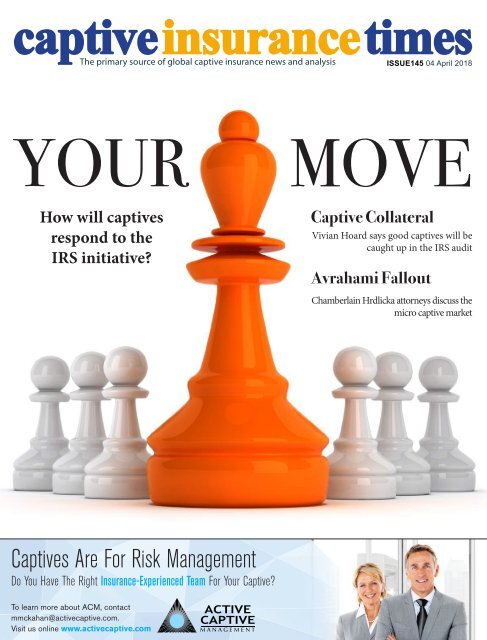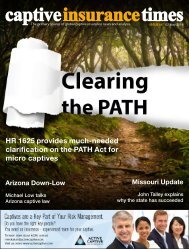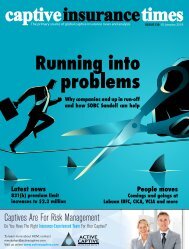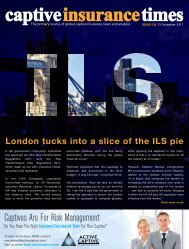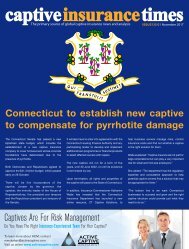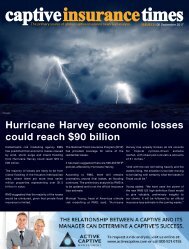Captive Insurance Times issue 145
In issue 145 of Captive Insurance Times, we focus on the Internal Revenue Service's ongoing campaign against illegitimate micro captives. Philip Karter, Scot Kirkpatrick, and Christopher Steele, attorneys at Chamberlain Hrdlicka, discuss the landscape of the micro captive market and the after-effects of the Avrahami case. You will also find our round-up of all the latest news and industry appointments. Don't forget to visit www.captiveinsurancetimes.com to read the latest news, scan the most recent issues, or check out upcoming events.
In issue 145 of Captive Insurance Times, we focus on the Internal Revenue Service's ongoing campaign against illegitimate micro captives.
Philip Karter, Scot Kirkpatrick, and Christopher Steele, attorneys at Chamberlain Hrdlicka, discuss the landscape of the micro captive market and the after-effects of the Avrahami case.
You will also find our round-up of all the latest news and industry appointments.
Don't forget to visit www.captiveinsurancetimes.com to read the latest news, scan the most recent issues, or check out upcoming events.
You also want an ePaper? Increase the reach of your titles
YUMPU automatically turns print PDFs into web optimized ePapers that Google loves.
ISSUE<strong>145</strong> 04 April 2018<br />
YOUR<br />
How will captives<br />
respond to the<br />
IRS initiative?<br />
MOVE<br />
<strong>Captive</strong> Collateral<br />
Vivian Hoard says good captives will be<br />
caught up in the IRS audit<br />
Avrahami Fallout<br />
Chamberlain Hrdlicka attorneys discuss the<br />
micro captive market<br />
<strong>Captive</strong>s Are For Risk Management<br />
Do You Have The Right <strong>Insurance</strong>-Experienced Team For Your <strong>Captive</strong>?<br />
To learn more about ACM, contact<br />
mmckahan@activecaptive.com.<br />
Visit us online www.activecaptive.com
Lead News Story<br />
Peter Mullen leaves Aon to return to Artex<br />
Peter Mullen has rejoined Artex Risk Management, leaving his<br />
role as CEO of Aon <strong>Captive</strong> and <strong>Insurance</strong> Management after<br />
seven years.<br />
David McManus will continue in his role as president and CEO of Artex<br />
until 1 July 2019, when he will move to the role as chairman, with Mullen<br />
succeeding him as president and CEO.<br />
Mullen will take up the role of CEO-elect in March 2019, once he<br />
has fulfilled his contractual obligations with Aon.<br />
The insurance veteran, who has more than 30 years experience in<br />
the industry, has stepped down from his role as CEO of Aon <strong>Captive</strong><br />
<strong>Insurance</strong> Management, where he spent seven years.<br />
A statement from Aon thanked Mullen “for his contributions to our firm<br />
and wish him well”.<br />
The statement added: “Rory Moloney, CEO of Aon Global Risk<br />
Consulting, will oversee the captive business until a new captives<br />
CEO is confirmed.”<br />
Mullen helped found Artex in 1997 and served on its executive team<br />
until he left for Aon in 2011.<br />
McManus commented: “As our executive committee considered the<br />
future leadership of Artex, we immediately thought of Peter Mullen<br />
and the value we could create by reuniting the team that originally<br />
founded Artex.”<br />
“I’m confident his strong technical risk understanding, coupled with his<br />
creativity and innovation, will continue to drive significant growth for<br />
Artex in 2019 and beyond.”<br />
“Everyone at Artex is focused on growth and that means strengthening<br />
our team where and when we can.”<br />
“Jennifer Gallagher, president of Artex North America, Nick Heys, CEO<br />
of Artex International, and I chatted this over early in the process and<br />
we all agreed the opportunity to entice Mullen back by offering him the<br />
top spot was too good to pass up.”<br />
www.captiveinsurancetimes.com<br />
3
Contents<br />
Acting Editor: Becky Butcher<br />
beckybutcher@blackknightmedialtd.com<br />
+44 (0)203 750 6019<br />
News Round-Up<br />
The UK government intends to amend the<br />
Reinsurance (Acts of Terrorism) Act of 1993<br />
page 6<br />
<strong>Captive</strong> Figures<br />
An update of the 2017 captive figures from<br />
domiciles around the world<br />
page 10<br />
Junior Reporter: Ned Holmes<br />
nedholmes@blackknightmedialtd.com<br />
+44 (0)203 750 6022<br />
Contributors: Jenna Lomax and Barney Dixon<br />
Associate Publisher/Designer: John Savage<br />
johnsavage@captiveinsurancetimes.com<br />
+44 (0)203 750 6021<br />
Publisher: Justin Lawson<br />
justinlawson@captiveinsurancetimes.com<br />
+44 (0)203 750 6028<br />
Avrahami Fallout<br />
Chamberlain Hrdlicka attorneys discuss the<br />
landscape of the micro captive market and<br />
consider whether the IRS doth protest too much<br />
page 14<br />
Danger Close<br />
Vivian Hoard of Taylor English says the IRS’s<br />
attempt to put a stop to unlawful captives will<br />
impact good captives<br />
Page 18<br />
Marketing Director: Steven Lafferty<br />
design@securitieslendingtimes.com<br />
+44 (0)203 750 6021<br />
Office Manager: Chelsea Bowles<br />
accounts@securitieslendingtimes.com<br />
+44 (0)203 750 6020<br />
Published by Black Knight Media Ltd<br />
Company reg: 0719464<br />
Copyright © 2018 Black Knight Media Ltd<br />
All rights reserved<br />
Industry Events<br />
Pick up your copy of <strong>Captive</strong> <strong>Insurance</strong><br />
<strong>Times</strong> at the latest industry events<br />
page 20<br />
Industry Appointments<br />
A tumultous few weeks at Aon forces us to<br />
ask, what’s going Aon?<br />
page 21<br />
<strong>Captive</strong>s in the U.S. Virgin Islands<br />
Form Your <strong>Captive</strong> in a U.S. Jurisdiction<br />
with Tax Benefits<br />
Office of the Lieutenant Governor - Division of Banking <strong>Insurance</strong> and Financial Regulation<br />
St. Croix<br />
1131 King Street, Suite 101, Christiansted, VI 00820<br />
Phone: 340-773-6459 Fax: 340-719-3801<br />
St. Thomas<br />
5049 Kongens, VI 00802<br />
Phone: 340-774-7166 Fax: 340-774-5590<br />
ltg.gov.vi<br />
www.captiveinsurancetimes.com<br />
5
News Round-Up<br />
UK to extend terror reinsurance<br />
The UK government intends to amend the<br />
Reinsurance (Acts of Terrorism) Act 1993 to<br />
enable an extension of the cover provided<br />
by Pool Re, the government-backed<br />
terrorism reinsurer.<br />
if there has been physical damage during a<br />
terror attack.<br />
Pool Re had identified the potential protection<br />
gap and suggested its cover be extended to<br />
ensure continued effectiveness in the face of<br />
an evolving threat.<br />
“This amendment will close the terrorism<br />
insurance gap for businesses up and down<br />
the country, which, combined with our efforts<br />
to make cover more affordable for smalland<br />
medium-sized enterprises and regional<br />
businesses across Great Britain, will increase<br />
the resilience of the economy.”<br />
According to a statement by John Glen,<br />
the economic secretary to the treasury,<br />
the amendment will extend Pool Re’s<br />
coverage to include business interruption<br />
losses that are not contingent on damage<br />
to commercial property.<br />
Presently, the reinsurer is limited by the<br />
1993 Act to only pay out in an instance<br />
when physical damage has occurred to<br />
commercial property.<br />
Businesses inside a police cordon that<br />
suffer financial losses due to loss of access<br />
to their property or trade are only covered<br />
The reinsurer has already collaborated<br />
with the government over the increased<br />
threat of cyber attacks and from April<br />
2018 it will extend its cover to include<br />
material damage and direct business<br />
interruption caused by acts of terrorism<br />
using a cyber trigger.<br />
Julian Enoizi, chief executive, Pool Re, said:<br />
“We welcome and applaud the government’s<br />
commitment to amend the 1993 legislation<br />
to allow Pool Re to be the first of the global<br />
terrorism pools to overtly extend its cover<br />
to include terrorism-related non-damage<br />
business interruption.”<br />
Glen said the government remained committed<br />
to “ensuring that businesses can continue to<br />
secure insurance against the financial cost of<br />
terror attacks”.<br />
He added: “I will announce further details in<br />
due course.”<br />
SIIA’s PATH Act changes included<br />
in appropriations bill<br />
The Self-<strong>Insurance</strong> Institute of America’s<br />
(SIIA) proposed clarifications to the<br />
Protecting Americans from Tax Hikes<br />
(PATH) Act have been included in the<br />
6 <strong>Captive</strong> <strong>Insurance</strong> <strong>Times</strong>
News Round-Up<br />
legislative text of the congressional<br />
omnibus appropriations bill.<br />
The recommended changes, which are a result<br />
of nearly two years of meetings and advocacy<br />
from SIIA and members of the industry, relate<br />
to the treatment of 831(b) captives within the<br />
PATH Act.<br />
In October 2016, SIIA, in collaboration with<br />
15 state captive insurance associations, sent<br />
a letter to the US Department of Treasury<br />
and the Internal Revenue Service requesting<br />
guidance and clarification around the PATH<br />
Act revisions to section 831(b).<br />
According to Ryan Work, vice president of<br />
government relations at SIIA, the proposed<br />
changes included in the legislature can<br />
be summarised as: “Clarification of the<br />
‘look-through’ language to the insured<br />
policyholders regarding first diversification<br />
test (20 percent rule); the clarification of<br />
the definition of ‘specified asset’ under the<br />
second diversification test to mean the<br />
aggregate amount of the relevant specified<br />
assets; and the clarification of specified<br />
asset and spousal ownership to address<br />
concerns surrounding community property<br />
and spousal attribution <strong>issue</strong>s.”<br />
Delaware to increase insurance<br />
commissioner authority<br />
Delaware has introduced a captive insurance<br />
bill which increases the authority of the State’s<br />
insurance commissioner (IC).<br />
evidence of the minimum capital and surplus<br />
required by chapter 69 and a certification<br />
from the captive owner that the application<br />
materials comply with the requirements of<br />
chapter 69.”<br />
The bill also noted: “A captive insurance<br />
company granted a conditional certificate of<br />
authority must pay the IC a fee of $100.”<br />
Additionally, it permits the IC to instantly<br />
revoke a conditional certificate of authority if<br />
they decide the captive has failed to comply<br />
with chapter 69 licensing requirements.<br />
The bill also includes technical corrections to<br />
align existing law with the standards of the<br />
Delaware Legislative Drafting Manual.<br />
It is now awaiting a hearing by the<br />
economic development/banking/insurance/<br />
commerce committee.<br />
DARAG forms strategic partnership<br />
with New Nordic<br />
DARAG has formed a strategic partnership<br />
with London-based investment management<br />
company New Nordic Advisors.<br />
The leading European legacy acquirer will<br />
collaborate with New Nordic in multiple project<br />
areas, including the provision of legacy, active<br />
business and restructuring solutions.<br />
DARAG’s Malta-domiciled protected cell<br />
company will form the joint consolidation platform.<br />
“New Nordic is evolving its strategy<br />
to provide alternative investment<br />
strategies with a focus on Northern<br />
Europe and Scandinavia.”<br />
Executive chairman of DARAG, Stuart Davies,<br />
said that the partnership was a milestone for<br />
the group and showcased their commitment<br />
to growth and a creative approach to future<br />
partnerships and projects.<br />
He added: “The partnership with<br />
New Nordic will also strengthen our<br />
bespoke client offering, which we<br />
tailor according to need, regardless of<br />
complexity or size.”<br />
Alex Roth, DARAG’s head of M&A, said:<br />
“This partnership is the result of an<br />
established close collaboration between<br />
our teams, common values and a shared<br />
commitment to provide solutions designed<br />
with a relentless focus on each individual<br />
client’s needs.”<br />
“Our joint cell in Malta will deliver both<br />
unrivaled legacy expertise and excellent<br />
asset management. Together, DARAG and<br />
New Nordic will provide a truly exceptional<br />
client offering.”<br />
XL Catlin installs Brexit<br />
continuity clause<br />
XL Catlin has installed a Brexit continuity<br />
clause to its London-based insurance<br />
operations.<br />
House Bill 334 amends Title 18 of the Delaware<br />
Code to authorise the IC to <strong>issue</strong> conditional<br />
certificates of authority to captive insurance<br />
candidates, which allows the applicant to<br />
conduct business while the IC completes the<br />
review of the application materials.<br />
The bill was introduced to the House of<br />
Representatives on 13 March 2018 by<br />
representatives Trey Paradee and Jeff<br />
Spiegelman, alongside senators Brian<br />
Bushweller and Bruce Ennis.<br />
According to the bill, conditional certificates of<br />
authority will only be <strong>issue</strong>d “upon receipt of<br />
A new cell jointly owned by DARAG and<br />
New Nordic will be established, subject to<br />
regulatory approval.<br />
New Nordic Capital, the asset management<br />
arm of the New Nordic group, will<br />
provide asset management capability,<br />
while DARAG will contribute its legacy<br />
management expertise.<br />
Nicolai Borcher Hansen, New Nordic CEO,<br />
commented: “This partnership signals the<br />
strong cooperation between our teams and<br />
opens the opportunity to explore further<br />
projects in a collaborative manner.”<br />
The clause addresses the risk that contracts<br />
written by the company’s London-based<br />
operations prior to Brexit may become<br />
impermissible if the passporting rights are<br />
lost as a consequence of the UK of leaving<br />
the European Union.<br />
It will be included in policies written by<br />
Catlin <strong>Insurance</strong> Company (CICLUK) and<br />
XL Catlin’s syndicate 2003 at Lloyd’s.<br />
Both CICLUK and syndicate 2003 will<br />
remain in the UK, while XL <strong>Insurance</strong><br />
Company SE (XLICSE) will move to Dublin,<br />
subject to regulatory approvals.<br />
www.captiveinsurancetimes.com<br />
7
News Round-Up<br />
Paul Greensmith, UK country leader and<br />
director of London market wholesale at XL<br />
Catlin, said: “Our innovative clause offers<br />
significant advantage by minimising the risk<br />
that policies will be cancelled, by making<br />
XLICSE a contingent party to the policy.<br />
Effectively, XLICSE will act as a back-up.”<br />
“A political solution may yet be forthcoming<br />
that ensures policies can be performed<br />
post-Brexit, but in the absence of one<br />
we believe this clause gives our clients<br />
and brokers the certainty they expect and<br />
deserve from their insurance partner.”<br />
XL Catlin’s Brexit contingency plans will<br />
not be impacted by the recent deal agreed<br />
for the acquisition of its parent group, XL<br />
Group, by AXA.<br />
Sura captive reinsurer rated ‘Good’<br />
A.M. Best has assigned captive reinsurer<br />
Sura Re with a financial strength rating of<br />
B++ (Good) and a long-term <strong>issue</strong>r credit<br />
rating of “bbb”.<br />
The outlook assigned to these ratings is stable.<br />
As the wholly-owned start-up captive<br />
reinsurer of Suramericana (Sura), Sura<br />
Re’s main role is to participate in property<br />
business written by Sura’s affiliates across<br />
Latin America.<br />
The ratings are reflective of Sura Re’s<br />
balance sheet strength, categorised as<br />
very strong, in addition to its adequate<br />
operating performance, limited business<br />
profile and appropriate enterprise risk<br />
management (ERM).<br />
Despite the strategic role that it will<br />
play in Sura’s overall regional strategy,<br />
Sura Re’s business profile is considered<br />
limited given its accessibility to<br />
markets when compared with other<br />
commercial reinsurers.<br />
According to A.M. Best, the reinsurer’s<br />
operating performance reflects nonrecurring<br />
expenses due to the company’s<br />
start-up nature and dependence on<br />
investment income, but its captive<br />
nature guarantees the company with a<br />
portion of well-underwritten risks by its<br />
affiliated companies.<br />
The rating agency added: “This provides<br />
flexibility in terms of growth and premium<br />
risk to efficiently manage its capital and<br />
return positions in the future.”<br />
Positive rating movement could occur if the<br />
captive can achieve its targeted geographic<br />
premium distribution with good quality<br />
underwriting in combination with a very<br />
strong balance sheet assessment.<br />
Failing to perform financially to an extent<br />
that leads to an impact in capital and<br />
therefore its risk-adjusted capitalisation<br />
may lead to negative rating actions.<br />
Bermuda captive conference to<br />
focus on diversity<br />
The 2018 Bermuda <strong>Captive</strong> Conference will<br />
focus on hot industry topics such as board<br />
diversity, female leadership, cyber risk,<br />
blockchain and climate change.<br />
The conference, which takes place<br />
between 11 and 13 June at Fairmont<br />
Southampton, will feature a mix of<br />
moderated panels and roundtables on a<br />
variety of current captive topics.<br />
Conference chair Michael Parrish explained:<br />
“Our agenda committee has worked hard<br />
and taken a fresh look to provide sessions<br />
we feel will be topical, thought-provoking<br />
and informative.”<br />
The 14th annual conference will also look<br />
at the perspective of millennials and female<br />
corporate leadership.<br />
Grainne Richmond, president of the<br />
Bermuda <strong>Insurance</strong> Management<br />
Association, commented: “It’s important<br />
to recognise the impact of diversity<br />
within the industry, particularly that of<br />
women, Bermudians, and young insurance<br />
professionals, as the captive insurance<br />
sector evolves.”<br />
“We’ll highlight some very successful<br />
women—senior executives who are<br />
excellent role models for young men and<br />
women. We feel their insights will inspire<br />
the whole audience, especially younger<br />
attendees who are just heading into<br />
captive careers.”<br />
A.M. Best affirms ratings of Energas<br />
The financial strength rating of A (Excellent)<br />
and long-term <strong>issue</strong>r credit rating of “a”<br />
of Energas <strong>Insurance</strong> Limited, has been<br />
affirmed by A.M. Best.<br />
The outlook of these ratings for Energas,<br />
the sole captive of Malaysia’s natural oil<br />
and gas company, Petroliam Nasional<br />
Berhad, is stable.<br />
The ratings are reflective of the captive’s<br />
balance sheet strength, which A.M. Best<br />
categorises as very strong, in addition to<br />
its strong operating performance, neutral<br />
business profile and appropriate enterprise<br />
risk management.<br />
Also incorporated in the ratings are<br />
Energas’ solid risk-adjusted capitalisation,<br />
comprehensive reinsurance programme<br />
and strong operating performance, as<br />
evidenced by a five-year average combined<br />
ratio of approximately 53 percent.<br />
According to the ratings agency:<br />
“Partially offsetting these positive rating<br />
factors is a reduction in prospective<br />
earnings derived from smaller premium<br />
volumes as Petronas scales back on its<br />
upstream activities.”<br />
“Nonetheless, A.M. Best expects Energas’<br />
active cycle management and efficient cost<br />
structure to buffer some of the negative<br />
pressure on its combined ratio and to aid in<br />
keeping overall earnings positive.”<br />
Though positive ratings movement is<br />
unlikely in the near term, negative ratings<br />
movement may arise should Energas’<br />
operating performance or risk-adjusted<br />
capitalisation deteriorate in the event of<br />
repatriation of capital.<br />
8 <strong>Captive</strong> <strong>Insurance</strong> <strong>Times</strong>
<strong>Captive</strong> Figures<br />
Kentucky<br />
The Kentucky Division of <strong>Insurance</strong><br />
licensed four new captive insurance<br />
companies in 2017, according to its yearend<br />
figures.<br />
All four of the new formations were<br />
pure captives.<br />
The division’s statistics also revealed that<br />
the state saw a reduction of 23 captives in<br />
2017, either via dissolutions, mergers, nonwriting,<br />
or re-domestications.<br />
As of 31 December 2017, there were 65<br />
active captives domiciled in the Bluegrass<br />
State, of which 54 were pure captives, eight<br />
were group/association captives and three<br />
were risk retention groups.<br />
The aggregate premiums written by<br />
Kentucky-domiciled captives last year was<br />
approximately $90 million, down from $96<br />
million in 2016.<br />
Russell Coy, insurance programme manager<br />
for the Division of Financial Standards and<br />
Examination, said the division had been<br />
active in the opening quarter of 2018.<br />
Coy commented: “We are in the process<br />
of licensing seven new companies<br />
(applications pending).”<br />
“In addition, we are working with another<br />
five to seven prospects.”<br />
Labuan<br />
Labuan licensed six new captives in 2017,<br />
according to the Labuan International<br />
Business and Financial Centre (IBFC) yearend<br />
figures.<br />
All of the new formations were pure captives.<br />
The IBFC’s figures also revealed that<br />
two licenses were surrendered last year,<br />
meaning as of 31 December 2017 the<br />
number of active captives domiciled in the<br />
territory was 43.<br />
Of the 43 captives, 33 were pure captives,<br />
four were protected cell captives, three<br />
were master rent-a-captives, two were<br />
subsidiary rent-a-captives and one was a<br />
rent-a-captive.<br />
Labuan’s six new captive formations in 2017<br />
were an increase on the year before, when<br />
there were two new captive formations in<br />
the domicile.<br />
Michigan<br />
Michigan-domiciled captive insurance<br />
companies exceeded $2 billion in written<br />
premiums for the first time in 2017,<br />
according to the Michigan Department of<br />
<strong>Insurance</strong> and Financial Services (DIFS).<br />
The DIFS figures also showed that three new<br />
captives were licensed last year, including<br />
one captive redomiciled from Bermuda.<br />
As of 31 December 2017, there were 22<br />
captive insurance companies domiciled in<br />
the Great Lakes State.<br />
DIFS director, Patrick McPharlin, commented:<br />
“Michigan’s reputation for having an ‘open<br />
door’ approach to government has helped<br />
Michigan succeed to this level in licensing<br />
captive insurance companies.”<br />
10 <strong>Captive</strong> <strong>Insurance</strong> <strong>Times</strong>
<strong>Captive</strong> Figures<br />
Nevis<br />
Nevis saw 14 new captive insurance company<br />
formations in 2017, according to the Nevis<br />
Financial Services’ year-end statistics.<br />
Oklahoma<br />
The Oklahoma <strong>Insurance</strong> Department<br />
licensed 14 captive insurance companies<br />
last year, according to its year-end figures.<br />
The statistics also showed that 26 captives<br />
were closed last year, meaning as of 31<br />
December 2017 there were 224 captive<br />
insurance companies domiciled in Nevis.<br />
Since the inception of its captive legislation<br />
in 2004, the Caribbean island has offered<br />
a well-regulated international domicile<br />
that provides a low-cost environment, in<br />
which no tax is paid on the premiums, net<br />
income, or assets of the captive.<br />
In comparison, 40 new captives were formed<br />
and 21 were closed in Nevis in 2016.<br />
Nevis Financial Services registrar of<br />
international insurance, Phil Jones,<br />
said: “2017 was significantly affected by<br />
uncertainty in the wider captive industry<br />
mainly caused by external forces.”<br />
He added: “In 2018, Nevis will continue<br />
to provide a well-adjusted regulatory<br />
framework with reasonable cost and<br />
high responsiveness to the requests of<br />
the end users.”<br />
“The Regulatory Commission remains<br />
confident that through collaborative<br />
relationships and industry awareness,<br />
Nevis will remain competitive as a favoured<br />
place to do business in the midst of a<br />
relatively changing business environment.”<br />
Oregon<br />
The Oregon Division of Financial Regulation<br />
licensed 10 new pure captive insurance<br />
companies last year, according to its yearend<br />
figures.<br />
The statistics also showed that six captive<br />
insurers closed operations, meaning as of<br />
31 December 2017 there were 14 captive<br />
insurance companies domiciled in the<br />
Beaver State.<br />
Oregon’s captive insurance law was<br />
passed in July 2012 and the state began<br />
accepting captive applications in the<br />
Autumn of that year.<br />
A spokesman from the Oregon Division<br />
of Financial Regulation said: “We are<br />
always looking to grow our captive insurer<br />
business. We have an experienced staff that<br />
works with captive managers, attorneys,<br />
and CPA’s to efficiently apply the law.”<br />
The spokesperson added: “Our hope<br />
is that this collaboration will lead to<br />
continued growth.”<br />
The statistics also revealed that as of<br />
31 December 2017 there were 73 active<br />
captives domiciled in the state.<br />
James Mills, deputy commissioner for the<br />
department, commented: “We are focused<br />
on providing stable regulation to the captive<br />
industry at a time where other sources are<br />
creating uncertainty.”<br />
He added: “Will continue to foster a<br />
business-friendly environment for new and<br />
growing captive insurance companies.”<br />
In 2016, Oklahoma licensed 17 new captives.<br />
You will find more information on<br />
all the captive jurisdictions in the<br />
<strong>Captive</strong> <strong>Insurance</strong> <strong>Times</strong><br />
Domicile Guidebook<br />
www.captiveinsurancetimes.com<br />
11
IRS Update<br />
Dirty dozen unlikely to impact captive industry<br />
The Internal Revenue Service’s (IRS) ‘Dirty Dozen’ list of tax scams<br />
will have little impact on the captive industry, despite micro captives<br />
appearing on the list for the fourth consecutive year, according to<br />
John Dies, managing director of tax controversy at alliantgroup.<br />
The IRS announced on 19 March that micro captives had once<br />
again been named on their ‘Dirty Dozen’ list, which outlines the tax<br />
scams that the IRS will be targeting over the coming year.<br />
The IRS suggested some micro captives may be used by promoters,<br />
accountants or wealth planners to persuade owners of closely-held<br />
entities to participate in schemes that lack many of the attributes<br />
of genuine insurance.<br />
Under section 831(b) of the tax code, captive insurers that qualify<br />
as small insurance companies can elect to exclude limited amounts<br />
of annual net premiums from income, so that the captive pays tax<br />
only on its investment income.<br />
The list suggested micro captives’ coverages may insure<br />
implausible risks, or duplicate commercial coverages with<br />
premiums that are significantly higher than those for comparable<br />
commercial coverage.<br />
Additionally, their policies may be ambiguous and deceptive and<br />
fail to meet regulatory standards, while their claims processes may<br />
be insufficient or completely absent, and insureds may fail to file<br />
claims that are allegedly covered under the captive insurance.<br />
The IRS added: “Micro captives may invest in illiquid or<br />
speculative assets or loans or otherwise transfer capital to or for<br />
the benefit of the insured, the captive’s owners or other related<br />
persons or entities.”<br />
“<strong>Captive</strong>s may also be formed to advance intergenerational wealth<br />
transfer objectives and avoid estate and gift taxes. Promoters,<br />
reinsurers and captive insurance managers may share common<br />
ownership interests that result in conflicts of interest.”<br />
According to Dies, being named on the list for a fourth consecutive<br />
year is unlikely to impact the captive industry or lead to a reduction<br />
in micro captive formations.<br />
He said: “I believe that the continued scrutiny of the IRS has caused<br />
a decrease in formation but being included in the 2018 Dirty Dozen<br />
is not likely to be much of an additional deterrent, since captives<br />
have been on the list for several years already.”<br />
“What will have a much greater impact is how the US Tax Court<br />
comes out on the cases that it has heard.”<br />
Dies suggested the actions of captive owners were unlikely to<br />
be influenced.<br />
He explained: “There is no specific guidance or requirements that<br />
are outlined in the release so the only action a taxpayer can take is<br />
not participate in a micro captive.”<br />
“It is clear that the Congress’ view differs from the IRS’s<br />
in this regard and taxpayers should not let the aggressive<br />
position of the IRS deter them from doing what is right for<br />
their business.”<br />
12 <strong>Captive</strong> <strong>Insurance</strong> <strong>Times</strong>
<strong>Captive</strong>s Are For<br />
Risk Management<br />
Do You Have The Right <strong>Insurance</strong>-Experienced Team For Your <strong>Captive</strong>?<br />
To learn more about ACM, contact<br />
mmckahan@activecaptive.com.<br />
Visit us online www.activecaptive.com
Avrahami Fallout<br />
TO SELF-INSURE<br />
OR NOT TO<br />
SELF-INSURE?<br />
That is the question<br />
Philip Karter, Scot Kirkpatrick and Christopher<br />
Steele, attorneys at Chamberlain Hrdlicka,<br />
discuss the landscape of the micro captive market<br />
and whether the IRS doth protest too much<br />
14 <strong>Captive</strong> <strong>Insurance</strong> <strong>Times</strong>
Avrahami Fallout<br />
In the wake of the Protecting Americans from Tax Hikes<br />
(PATH) Act changes to section 831(b), Notice 2016-66 and the<br />
Avrahami decision, we must ask whether ‘tis nobler to suffer<br />
the slings and arrows of a possible IRS attack or to take arms<br />
against a sea of troubles with micro captives and by opposing,<br />
end them? While some may be tempted to avoid the “natural<br />
shocks that [micro captives are] heir to”, business owners who<br />
are committed to forming and operating them correctly should<br />
not be dissuaded.<br />
Risk management is essential to the health of any business and<br />
Congress has encouraged it by incentivising businesses to form<br />
captive insurance companies. For micro businesses, Congress<br />
has created an additional incentive under section 831(b) of<br />
the tax code, which allows their associated captive insurers to<br />
exclude premium income from tax altogether, up to a specified<br />
annual dollar limit of $2.3 million in 2018.<br />
But the picture is not entirely rosy. Although most captives<br />
are formed for valid businesses reasons and operated as true<br />
insurance companies, the significant tax exemption available to<br />
micro captives has prompted the IRS for a number of years to<br />
attack a broad range of micro captives as abusive tax-motivated<br />
transactions. Many tax practitioners consider the IRS’s attack<br />
overbroad and coercive with insufficient attention paid by<br />
auditors to distinguishing legitimate arrangements from others<br />
that are poorly conceived, formed and operated.<br />
Despite its heavy-handed approach to casting a wide audit<br />
net for micro captives and their insureds, the IRS did have<br />
legitimate concerns that section 831(b) provided insufficient<br />
protections from taxpayer abuse by generating tax deductions<br />
for unnecessary insurance while transferring wealth between<br />
business owners’ family members.<br />
Lessons from Avrahami<br />
Despite the adverse outcome, Avrahami can reasonably be<br />
described as a bad facts case that represents a cautionary<br />
tale for captive planners to do their homework. This includes<br />
ensuring that the captive arrangement has, among other<br />
things, a solid non-tax business purpose behind the issuance<br />
of each policy, commercially reasonable policy terms,<br />
defensible risk premiums, appropriate claims review and<br />
payment procedures and sufficient liquidity in the captive to<br />
actually pay claims should they arise. Further, there must be<br />
adequate risk distribution for the arrangement to be respected<br />
as insurance.<br />
Before the Avrahami decision, the IRS was already taking a<br />
very hard line in micro captive audits, routinely disallowing<br />
captive premium deductions and forcing taxpayers to fight it<br />
out with appeals or file petitions in tax court. The unfortunate<br />
consequence of this hostile environment has been that little effort<br />
has been made by auditors to distinguish one section 831(b) case<br />
from another. Unsurprisingly, the Avrahami decision has only<br />
increased the IRS’s hubris in taking hardline positions in audits<br />
and even administrative appeals. Unfortunately, this means many<br />
taxpayers with legitimate captive insurance arrangements have<br />
been caught up in the assault.<br />
Although IRS ‘chest-thumping’ may increase the trepidation<br />
some taxpayers have about utilising micro captives, a company<br />
that faces significant insurable business risks should not be<br />
deterred from taking the section 831(b) tax election. As other<br />
decisions come down from the courts, it will be increasingly<br />
apparent that, like every other congressionally authorised taxadvantaged<br />
transaction that has been challenged by the IRS over<br />
the years, the facts do actually matter.<br />
On August 21, 2017, after more than a two-year wait, the<br />
US Tax Court, in Avrahami v Commissioner, finally <strong>issue</strong>d<br />
the first decision in a case involving a section 831(b)<br />
micro captive. Unsurprisingly, the decision went badly for<br />
the taxpayers and the deductions claimed for insurance<br />
premiums paid to the captive were disallowed; however, no<br />
penalties were imposed.<br />
Although the deck may appear stacked against micro captives<br />
in light of the continued attack by the IRS and the recent ruling<br />
in Avrahami, captives remain a legitimate business arrangement<br />
under the code. As long as a micro captive is set up and<br />
operated as a true insurance company covering bona-fide<br />
insurable business risks, they continue to provide significant<br />
risk-mitigation benefits to business owners as well the favorable<br />
tax treatment Congress intended by enacting section 831(b).<br />
The key to avoiding (or winning) an attack on a micro captive by<br />
the IRS is in the details.<br />
Avoiding IRS attacks and developing a winning strategy<br />
Taxpayers must approach the use of micro captive insurance<br />
companies with a focus on inoculating the captive from a<br />
potential attack. Moreover, it is as critical that taxpayers avoid<br />
certain ‘hot-button’ transactions that invite scrutiny.<br />
Proper captive formation and operation:<br />
To qualify as a captive insurance company, the captive must<br />
actually provide insurance and have appropriate risk shifting and<br />
risk distribution. The concept of what constitutes insurance has<br />
long been debated by the courts, but more specific guidelines<br />
have now been developed.<br />
As is true with any business planning, a captive must possess<br />
a legitimate business reason to avoid being treated by the IRS<br />
as a tax-motivated sham transaction. Every business reason for<br />
www.captiveinsurancetimes.com<br />
15
Avrahami Fallout<br />
forming a captive should be fully analysed, documented at the<br />
outset and reevaluated over time. Insureds that periodically adjust<br />
their coverage to align with changing business considerations<br />
present better arguments that risk minimisation, not tax, is the<br />
primary motivator.<br />
A good rule of thumb is that if the taxpayer cannot think of<br />
a good reason why its business needs insurance coverage<br />
for a particular risk, it should not simply rely on a third-party<br />
advisor recommending coverage for that risk. The goal is<br />
not to hit a target number for the total premiums paid to<br />
the captive, but rather to insure the risks that need to be<br />
mitigated by paying for fairly-priced insurance coverage,<br />
whatever its cost may be.<br />
Proper management and operation of a captive is essential to its<br />
success. Caution should be exercised to avoid captive managers<br />
who set up a captive but do not provide it with any true risk<br />
management services, both to insure success of the venture and<br />
to avoid problems with the IRS.<br />
Factors to consider:<br />
• Business purpose: Every captive transaction should begin<br />
with an assessment of the insurance risks borne by a<br />
business not by a tax savings analysis. Similarly, it is best if<br />
the recommendation to consider a captive risk management<br />
strategy originates with a recommendation from an insurance<br />
professional not a tax advisor.<br />
• Avoiding excessive premiums: Under section 162(a),<br />
insurance premiums paid by a taxpayer are deductible<br />
if they are connected directly with the taxpayer’s trade<br />
or business and represent an ordinary and necessary<br />
business expense.<br />
Even though insureds may be incentivised to pay higher<br />
captive premiums for coverage than they would want to<br />
pay a third-party insurer, paying premiums consistently<br />
higher than the actual loss claims are an indicator that the<br />
taxpayer is primarily tax motivated. Another red flag for the<br />
IRS is when a captive is charging premiums in an amount<br />
close or equal to the premiums threshold exemption under<br />
section 831(b).<br />
• Reliable actuarial method: One of the reasons taxpayers<br />
undertake captive insurance is because there is no<br />
commercial counterpart to cover such risks. In that case,<br />
there is no available pricing data to compare captive<br />
premiums to third-party insurance coverage. Consequently,<br />
it will be necessary to rely on actuarial forecasts to analyse<br />
the taxpayer’s loss history and to project the timing and size<br />
of future claim payments.<br />
• Loan-backs: A captive that lends money back to an<br />
operating business which is insured by the captive is often<br />
referred to as a loan-back. A loan-back is used to invest the<br />
assets of the captive back into the operating business. The<br />
IRS carefully scrutinises loan-backs and has contemplated<br />
issuing regulations relating to them. Such an arrangement<br />
was present in Avrahami, and the court did not look upon<br />
it favorably.<br />
• Retroactive premiums: Policies that cover time periods<br />
already expired (for example, retroactive coverage) are<br />
highly frowned upon as an indicator that the captive<br />
arrangement is not legitimate. Taxpayers are well advised to<br />
avoid retroactive coverage, particularly in the absence of a<br />
strong and consistent claims history.<br />
• Exotic coverages: Much has been written in Avrahami and<br />
elsewhere about the issuance of captive coverage in the<br />
event of terrorism, although the IRS’s criticisms of exotic<br />
coverages are not limited to that. It simply bears repeating<br />
that the coverage should match the business.<br />
• Standard coverages: The micro captive exemption is<br />
specifically devised from a tax inducement perspective to<br />
insure ‘low frequency, high severity’ types of risk. These<br />
risks (for example, earthquake, flood, crop, hurricane,<br />
even loss of key customers, supplies or an employee)<br />
do not occur often, but when a loss occurs, it is usually<br />
devastating. To address this concern, Congress wanted<br />
to encourage the accumulation of capital unreduced by<br />
taxation for these infrequent, but potentially disastrous<br />
occurrences, which can be fatal to a business. The IRS has<br />
argued the infrequency of claims is evidence of a sham.<br />
Given the IRS’s position, a taxpayer would be prudent<br />
to mix lower severity and higher frequency risks into<br />
the captive coverage such as a high deductible workers<br />
compensation plan, a portion of the self-insured retention<br />
in a commercial liability insurance policy, or even medical<br />
stop loss coverage. These coverages are very likely to<br />
generate some claims every year which may dissuade the<br />
IRS from attacking.<br />
• To elect or not to elect section 831(b) status: The<br />
election of section 831(b) should not be automatic.<br />
Rather consideration should first be given to the type<br />
of coverages needed and then an analysis should be<br />
prepared to determine whether it is advisable. It may<br />
be that treating the captive as a large captive under<br />
the normal rules of section 831(a) is most appropriate,<br />
particularly if the coverage needs are substantial.<br />
Moreover, starting out as a section 831(a) micro captive<br />
does not preclude a section 831(b) election in future<br />
years if appropriate.<br />
16 <strong>Captive</strong> <strong>Insurance</strong> <strong>Times</strong>
Avrahami Fallout<br />
Preparing a captive for a fight<br />
Beyond the proper formation and operation of a captive, there<br />
are a number of key factors the IRS will invariably focus on<br />
when auditing small captive arrangements with a predisposition<br />
toward disregarding them.<br />
By taking these factors into consideration during the planning,<br />
formation and operational stages of the captive’s lifespan, and<br />
consistently reevaluating them to take into account changing<br />
business and risk circumstances, taxpayers will be far better<br />
prepared to successfully withstand an IRS challenge.<br />
• Is there a documented business purpose for the formation<br />
and operation of the captive?<br />
• Does the captive have a defensible feasibility study and<br />
business plan?<br />
• Is the captive adequately capitalised?<br />
• Are the insurance coverages written by the captive legitimate<br />
and consistent with the needs of the business?<br />
• Is the policy language commercially reasonable and does it<br />
actually provide coverage for the risks insured?<br />
• Are the coverages standard or would they be considered<br />
exotic in nature?<br />
• Is there valid and documented support for the pricing of<br />
premiums each year?<br />
• Are actual (and meaningful) claims being made against<br />
the captive policies? If so, are those claims being paid<br />
by the captive?<br />
• Are the captive reserves being invested to ensure liquidity in<br />
the event of significant claims?<br />
• Are distributions being made from the captive? If so, do they<br />
appear to reflect a circular flow of cash?<br />
• Are there any loan backs by the captive?<br />
• Are premiums written prospectively or retroactively?<br />
Phillip Karter,<br />
Phillip Attorney, Karter, Chamberlain Hrdlicka<br />
Attorney, Chamberlain Hrdlicka<br />
Scot Kirkpatrick,<br />
Attorney, Chamberlain Hrdlicka<br />
Conclusion<br />
Although the past three years have caused many taxpayers to<br />
second guess the wisdom of using micro captives, section 831(b)<br />
remains a congressionally endorsed and highly valuable option for<br />
small businesses to effectuate cost-effective risk minimisation.<br />
Indeed through the PATH Act, Congress has doubled down on its<br />
commitment to micro captives by almost doubling the premium<br />
income excluded from income tax.<br />
Ay, there’s the rub! Instead of being deterred from taking<br />
advantage of the benefits micro captives can provide,<br />
taxpayers should approach them with the same caution and<br />
diligence as any other congressionally authorised planning<br />
arrangement, including acquiring guidance from professionals<br />
who know where the pitfalls of such arrangements are and how<br />
to avoid them. CIT<br />
Christopher Steele,<br />
Attorney, Chamberlain Hrdlicka<br />
www.captiveinsurancetimes.com<br />
17
Market Update<br />
Danger close<br />
The IRS’s attempt to put a stop to unlawful micro captives means legitimate<br />
captives will be caught up as collateral, Vivian Hoard, partner at Taylor<br />
English, explains that good captives need to stand up and fight their case<br />
Ned Holmes reports<br />
On 20 March, the Internal Revenue Service (IRS) named<br />
micro captives on their ‘Dirty Dozen’ list of tax scams for<br />
the fourth consecutive year. The much-anticipated move is a<br />
continuation of the IRS’s campaign to put a stop to the micro<br />
captives that are abusing the 831(b) tax election and are set<br />
up purely for tax purposes.<br />
What happened when all this started was tax professionals were<br />
doing and promoting these transactions without the assistance<br />
of insurance professionals, so, there wasn’t risk shifting or risk<br />
distribution, or insurance in the general sense. It is those types<br />
of micro captive transactions that the IRS is targeting. It is the<br />
inappropriate micro captives that should be worried. The legitimate<br />
micro captive market shouldn’t be too concerned, however, some<br />
of them will get caught by the IRS in audits and they’re going to<br />
have to defend against those audits even if they are legitimate.<br />
A landmark moment in the IRS’s campaign came with the Avrahami<br />
verdict in August 2017 and the court’s ruling continues to influence<br />
the captive industry. We spoke to Vivian Hoard, partner at Taylor<br />
English, about her thoughts on the post-Avrahami micro captive<br />
market and whether the good captives caught up in IRS audit<br />
campaign should stand up to their accusers.<br />
What impact will micro captives featuring on the<br />
IRS’s ‘Dirty Dozen’ list have on the captive industry?<br />
Vivian Hoard: It shouldn’t have any impact on the legitimate<br />
micro captive market at all. Micro captives are legal and perfectly<br />
appropriate. The government is trying to get at transactions that<br />
are tax motivated rather than insurance motivated.<br />
I don’t see the market slowing down post-Avrahami. People<br />
who are doing the transactions, if they think they’re doing them<br />
appropriately aren’t going to slow down at all. It may slow down<br />
the tax driven promoters and that is the goal, that’s what the IRS<br />
is hoping for.<br />
What are the key things micro captives can learn<br />
from the Avrahami verdict?<br />
What people need to realise is that a micro captive is an<br />
insurance company. It has to act like an insurance company<br />
and really be insurance in the legal sense that we understand<br />
it. There needs to be risk shifting, risk distribution and a real<br />
risk that should be actuarially calculated and I think if they do<br />
18 <strong>Captive</strong> <strong>Insurance</strong> <strong>Times</strong>
Market Update<br />
all of that and they are appropriately insuring a legitimate risk<br />
then they should be fine.<br />
If the premium is comparable to a market premium then there<br />
shouldn’t be any problem with insuring your own risk and being<br />
incentivised to manage your own risk.<br />
Everybody seems to be very worried about the post-Avrahami<br />
market and even legitimate captive managers are a little bit<br />
worried because they know some of them are going to get caught<br />
up in the IRS web of audits.<br />
But I don’t think anyone who is really using micro captives for<br />
legitimate insurance needs the way they should be done has much<br />
cause for concern because Congress increased the deductible<br />
amount from $1.2 million to $2.2 million recently so they’re<br />
sending the message that it is a legitimate form of managing risk<br />
if it is done appropriately and the IRS is just trying to go after the<br />
people who are abusing it and using it as a tax shelter.<br />
Is there anything good micro captives can do to<br />
avoid being caught up in IRS audits?<br />
There will be legitimate micro captives that get caught up in<br />
audits. Since this is a campaign audit, people at the lower level<br />
of the audit process will lose discretion. Since it is a coordinated<br />
<strong>issue</strong> one group of people decide the cases and these cases move<br />
up through that coordinated structure. Sometimes the IRS won’t<br />
figure out that a legitimate captive is legitimate until everyone is<br />
on the courthouse steps or until a judge decides. Unfortunately<br />
people are going to get caught in that process.<br />
How effective will the IRS campaign against bad<br />
micro captives be? Will we see a reduction in the<br />
numbers set up for tax purposes?<br />
No, not until we see more IRS activity. My understanding is there<br />
is several criminal cases out there brewing.<br />
What the IRS sometimes does is find one particular person that is<br />
behaving in an egregious manner, they will try to prosecute them<br />
and then they will publicise that prosecution because they don’t<br />
have the funds to deal with everyone and once they prosecute that<br />
one person it is theoretically supposed to scare other people into<br />
compliance. So, I think we might see some more criminal cases.<br />
Can you see the IRS shifting their focus to the<br />
larger captive market anytime soon?<br />
million. The micro captive takes that $2.2 million and they don’t<br />
have to pay tax on the receipt of the premium, they just have to<br />
pay tax on the investment income. So a lot of tax professionals<br />
were setting up these micro captives and there was actually no risk<br />
involved. They didn’t have risk distribution or shifting, they were<br />
just setting aside some money they can deduct from one company<br />
and put it in another company. Those are the kind of transactions<br />
the government is after, where no claims are going to be made<br />
and they’re just saving up money in a tax advantageous way in<br />
another company that they will dissolve down the road, pocket it<br />
and save tax on the $2.2 million. It is that kind of transaction that<br />
the government is trying to target.<br />
People are buying terrorism insurance—do you really spend<br />
$2.2 million in terrorism insurance? No, nobody is going to pay<br />
that. That is what the IRS is going after, they’re not going after<br />
legitimate transactions although legitimate transactions are going<br />
to get caught in the mix.<br />
Is it important that legitimate micro captives stand<br />
up to the IRS and fight their case?<br />
Absolutely legitimate small captives need to fight the IRS.<br />
Absolutely they need to go to trial. Don’t roll over and play dead.<br />
There are two ways taxpayers can handle the dispute. They can<br />
litigate in tax court, which you don’t have to pay the tax if you<br />
litigate in tax court, or they can pay the tax in dispute and sue<br />
for a refund in district court. If you’re not guilty and you haven’t<br />
done anything wrong you need to fight it. You will get a fair trial in<br />
the United States tax court and you will get a fair trial in a district<br />
court, but, no you should not pay something you do not owe.<br />
They all need to fight their cases. If they’re a good captive and<br />
they get caught up in this they definitely need to litigate, they<br />
do not need to roll over. You can litigate cost effectively in either<br />
forum. Definitely, anyone who doesn’t owe tax needs to fight it.<br />
Go and get a fair trial.<br />
Do you think the more legitimate captives that fight<br />
the IRS, win and set a precedent, the less colateral of<br />
good micro captives that are likely to get caught up?<br />
Yes. The IRS doesn’t like to pursue a case unless they think they can<br />
win it. I’m not a big fan of these campaign audits because they have<br />
this one size fits all approach, and it doesn’t work. When the IRS<br />
lose several of these then they will decide they need to be a bit more<br />
selective and analyse their cases better and that’s what happens.<br />
No, I don’t see that happening. The IRS is looking for people<br />
misusing the 831(b) tax election. If you make the election you can<br />
deduct up to $2.2 million in premiums so the business can pay<br />
for premiums to their own micro captives and deduct up to $2.2<br />
When you try a case in tax court, at the end of the trial you brief a<br />
case and then it might be two years later before the judge <strong>issue</strong>s<br />
an opinion but you get immediate gratification in district court with<br />
a jury. CIT<br />
www.captiveinsurancetimes.com<br />
19
Industry Events<br />
Don’t miss your copy of <strong>Captive</strong> <strong>Insurance</strong> <strong>Times</strong><br />
RIMS<br />
Texas<br />
TxCIA Conference<br />
Texas<br />
April<br />
15-18<br />
rims.org<br />
May<br />
21-22<br />
texascaptives.org<br />
WRCIC<br />
Missouri<br />
Bermuda <strong>Captive</strong> Conference<br />
Bermuda<br />
May<br />
21-23<br />
westerncaptiveconference.org<br />
June<br />
11-12<br />
bermudacaptiveconference.com<br />
20 <strong>Captive</strong> <strong>Insurance</strong> <strong>Times</strong>
Industry Appointments<br />
Comings and goings at Aon<br />
Aon UK has appointed Nathan Shanaghy to replace David<br />
Ledger as COO, with Ledger due to retire at the end of March.<br />
Shanaghy moves over from his current roles as COO of Aon Risk<br />
Solutions UK and London Global Broking Centre.<br />
He will start his new role and join the Aon UK board on 1 April and<br />
will report to Aon UK CEO Julie Page.<br />
Page commented: “I have worked closely with Nathan Shanaghy<br />
since joining Aon, and know that he will be a great successor to<br />
David Ledger.”<br />
“I know I speak on behalf of the whole of the UK board in saying<br />
that we are very much looking forward to working with Shanaghy<br />
to manage the risk business in the UK. ”<br />
Page also thanked Ledger, who spent 21 years at Aon, for his<br />
dedication to both the company and the industry.<br />
“I would also like to thank John Nicholson for the excellent job he<br />
has done as interim CRO and wish him well as he returns to his<br />
role as a non-executive director on the Aon UK Ltd board.”<br />
Aon Benfield, the global reinsurance intermediary and<br />
capital advisor of Aon, has expanded the management of its<br />
Bermuda team.<br />
The move is aimed at optimising the growing opportunities for<br />
clients and markets to deploy capital and expertise on the island.<br />
Matthias Meyenhofer will join as CEO of Aon Benfield Bermuda<br />
on 1 September, transferring from his current role as head of<br />
Europe, the Middle East and Africa (EMEA) global clients at<br />
Guy Carpenter.<br />
Jonathan Davies, currently a member of the London-based Aon<br />
Benfield Global ReSpecialty Executive, will become head of Aon<br />
Benfield Global ReSpeciality Bermuda as of 1 April.<br />
She said: “Both the board and I have valued his experience and<br />
counsel in a variety of leadership positions within the firm. We<br />
wish him all the best in his retirement.”<br />
The current chairman of Aon Benfield Global ReSpecialty<br />
Bermuda, Tony Fox, will move to the role of chairman of Aon<br />
Benfield Bermuda.<br />
Aon UK has appointed Matt Kimber as its new Chief Risk<br />
Officer (CRO).<br />
Fox said: “The addition of these two experienced team members<br />
signals the beginning of the expansion of our Bermuda platform.”<br />
Kimber replaces John Nicholson, who has served as interim CRO<br />
for the last 11 months.<br />
He added: “Matthias Meyenhofer and Jonathan Davies will play<br />
key roles in helping to drive our strategic growth objectives.”<br />
A 20-year insurance veteran, Kimber joins Aon from JLT, where<br />
he has been head of risk and compliance for the last five years.<br />
Prior to his time at JLT, Kimber held roles at Marsh, Lloyds<br />
and HBOS.<br />
He will report to Julie Page, CEO of Aon UK, subject to regulatory<br />
approval, and will join the Aon UK board.<br />
UK CEO of Aon Benfield, Nick Frankland, who oversees the firm’s<br />
Bermuda operations, commented: “Augmenting our resources in<br />
this way reflects Aon Benfield’s commitment to Bermuda, and is<br />
in recognition of the widening experience, skill sets and capital<br />
now available on the island, and of our desire to better access<br />
Bermuda capabilities in support of our global model.”<br />
All moves are subject to Bermuda immigration approval. CIT<br />
Page commented: “Matt Kimber brings great energy and<br />
experience to our Risk and Compliance team and we are delighted<br />
to have him on board.”<br />
Do you have an industry appointment we should cover?<br />
Get in touch via:<br />
nedholmes@blackknightmedialtd.com<br />
www.captiveinsurancetimes.com<br />
21


